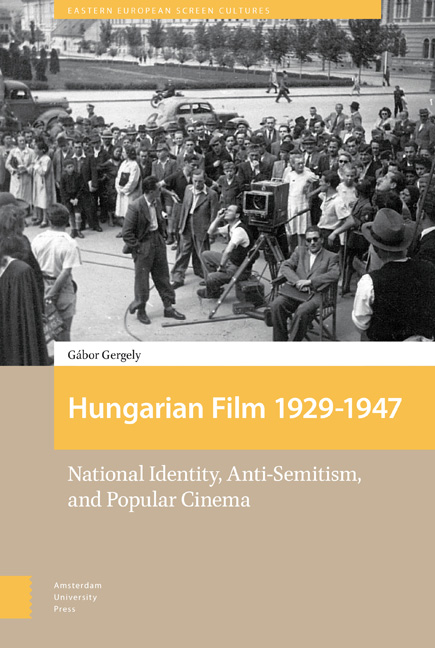Book contents
- Frontmatter
- Dedication
- Contents
- List of Illustrations
- Acknowledgements
- A Note on Accents, Pronunciation, Names, and Spellings
- Preface
- Introduction
- 1 Key Concepts in Pre-1945 Hungarian Cinema
- 2 A Contested Film History
- 3 An Industry Emerges 1931-1935
- 4 Boom, Crisis and Anti-Semitic Reorganization 1936-1941
- 5 From War Boom to Bust 1941-1944
- Epilogue: Industry Reboot and the Myth of a New Start 1945-1947
- Concluding Remarks
- Bibliography
- Index
5 - From War Boom to Bust 1941-1944
Published online by Cambridge University Press: 11 December 2020
- Frontmatter
- Dedication
- Contents
- List of Illustrations
- Acknowledgements
- A Note on Accents, Pronunciation, Names, and Spellings
- Preface
- Introduction
- 1 Key Concepts in Pre-1945 Hungarian Cinema
- 2 A Contested Film History
- 3 An Industry Emerges 1931-1935
- 4 Boom, Crisis and Anti-Semitic Reorganization 1936-1941
- 5 From War Boom to Bust 1941-1944
- Epilogue: Industry Reboot and the Myth of a New Start 1945-1947
- Concluding Remarks
- Bibliography
- Index
Summary
Reflecting the difficulty of dividing the era into neat and distinct periods, this chapter begins with the final year of the previous period. It takes in the peak years, 1941 to 1943, and the nadir, 1944, of wartime film production in Hungary. The question of periodization, as has been explored earlier, is very important to this discussion. Drawing the line in winter 1938-1939, as most scholars of Hungarian cinema have done, acts to give legitimacy to the anti-Semites’ arguments about the transformative potential of the ban on Jewish Hungarian participation in the film sector and fudges the key continuities and constancies, while inflating the significance of differences. Taking 1941 as the beginning of the boom-to-bust period of Hungary's war (which started with the declaration of war against the USSR in that year), helps us see the real changes brought about by the sector's anti-Semitic reorganization. These included the shift to a wartime industry devoted to the dissemination of morale boosting films, the assertion of full control over the sector by the state, which was not completed until after the departure in December 1939 from the Film Chamber's executive board of those anti-Semitic activists who had shared with their Jewish Hungarian colleagues the vision of genuine industry representation (see ‘Putsching the Putschists’), and the final round of anti-Jewish legislation in 1941, which introduced narrowly racist definitions of ‘the Jew’, eschewing the previously used faith-based definition.
The state can be seen to be in full control of the sector by February 1942, when Magyar Film announced in an editorial the introduction of a new unified ticketing system (1942. 5, 1). This was designed to ensure that all duties and taxes calculated as a charge per head of audience could be fairly and transparently collected. This shows the extent to which competition had been stamped out from the marketplace. This was effectively a stateowned industry providing a service held to be of strategic importance, charged at standard rates inclusive of proportional and fixed charges, operated by state-licensed private entrepreneurs, allowed to retain any profits that remained after the state's share had been paid from gross takings. In exchange, the state used some of these revenues to provide subsidies to businesses with a track record of successful productions. Furthermore, the state ensured that competition for the audience was limited.
- Type
- Chapter
- Information
- Hungarian Film, 1929–1947National Identity, Anti-Semitism and Popular Cinema, pp. 227 - 296Publisher: Amsterdam University PressPrint publication year: 2017



